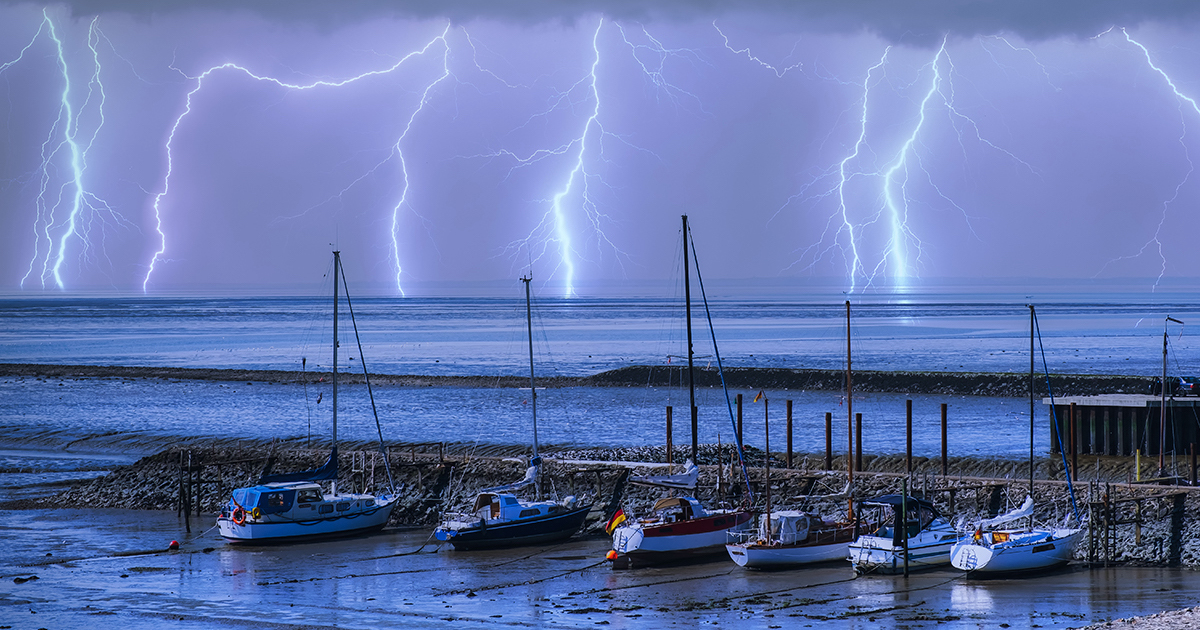
By Randy Carnahan, Executive Vice President, Marine Practice Group
Summer is the active season for thunderstorms and lightning. In the Chesapeake Bay, you can almost set your watch by the arrival of thunderstorms during late August afternoons. Florida is another “hot spot” for lightning. This causes yacht insurance to be a more difficult and expensive placement in the sunshine state.
Lightning strikes are as old as time itself. Early on, mankind learned, during a thunderstorm, not to take shelter under the tallest tree in the forest. Nevertheless, when people learned to sail, they essentially brought “tall trees” with them as masts, and suffered fires and blown-up rigs from lightning. When fiberglass boats and aluminum masts arrived, the problem grew worse. Lightning found the masts an attractive conduit to the sea, travelling down the mast and blowing a hole in the bottom of the boat.
Lightning has always been a major concern in boating safety. That concern carries over to yacht insurance because lightning is one of the principle causes of loss, and this is expected to grow both in terms of frequency and claim amount in coming years. The journal Science reports that “lightning is positively correlated with surface temperatures over short periods of time,” and expects lightning frequency to increase 12% for each 1⁰ C rise in environmental warming.
More Lightning, More Costs
The size of claims arising from lightning strikes is also increasing. Boats themselves cost more today, resulting in higher repair and replacement expenses. A large factor contributing to this is the increased number and value of electronics aboard boats and yachts today. Not long ago, offshore-capable yachts carried a VHF and SSB. Through the mooring field, they were pushed along by small diesels that could be crank-started if the battery failed. Now engines are electronically controlled, and sails may be electronically controlled. There is a generator running the air conditioner, and the VHF and SSB are now joined by an entertainment center, including stereo and HD flatscreen TV’s. Radar, chart plotters, and computers are a part of the everyday cruising package. These electronics are expensive, which drives up the claims expense.
Bigger, more expensive boats. More electronics at a higher cost. Boaters see the results in their insurance policies. Policy deductibles for electronics were very low―perhaps $250 or $500―not so long ago. Now, lightning strike deductibles may be 10% of hull value in certain parts of the country. Hull premiums are rising as well in part because of lightning.
The Solution: What You Can Do
We may not be able to prevent lighting strikes, but we can mitigate the consequences for safety and damage control. Familiarize yourself with the subject. Detailed technical information is available from ABYC, NMMA, and BoatUS. A very helpful plain-English discussion on the topic is on yacht designer Michael Kasten’s website.
When buying a new boat, ask the dealer for information on the boat’s lightning protection system, including the size of grounding cables or strips. If the engine is separately grounded, determine whether there are “exit terminals” or perimeter grounding provided. If you are buying a brokerage boat, make sure the surveyor specifically inspects the lightning protection system and that grounds are in good order, the dyna plate has not been painted over, and conductors do not have any sharp bends.
Stay safe out there, protect yourself and your assets, and save money!
